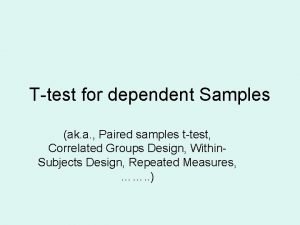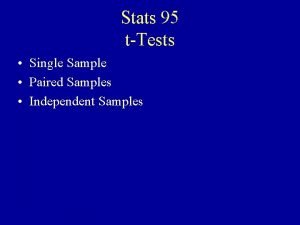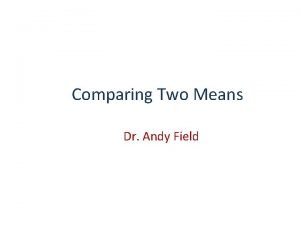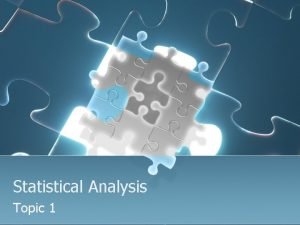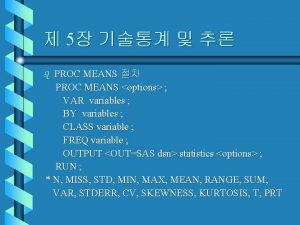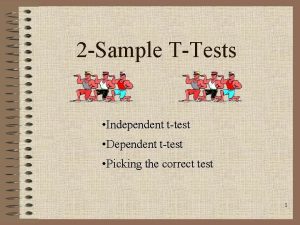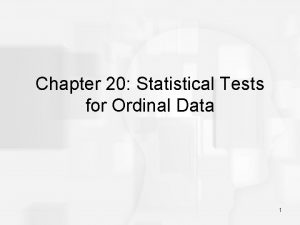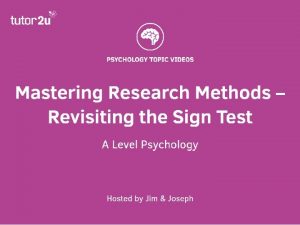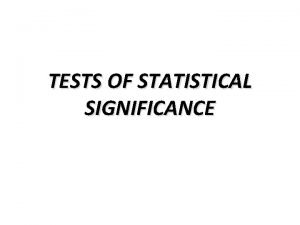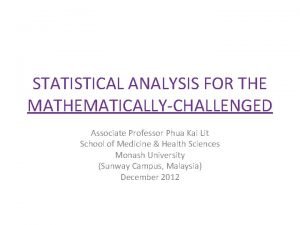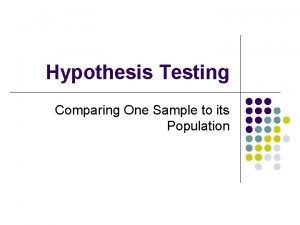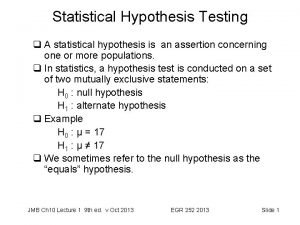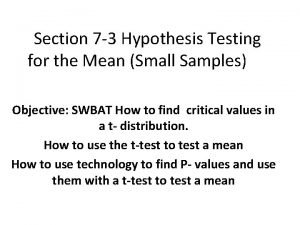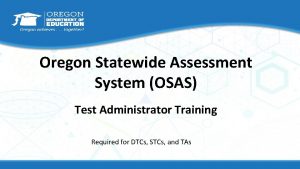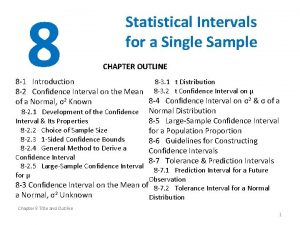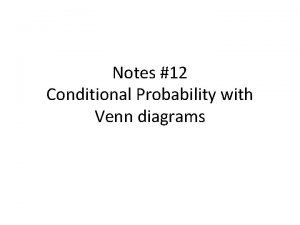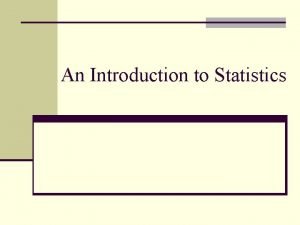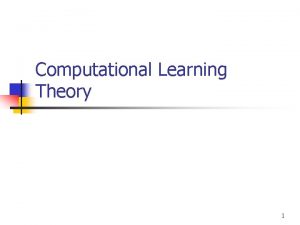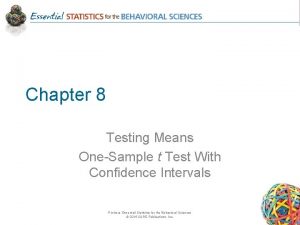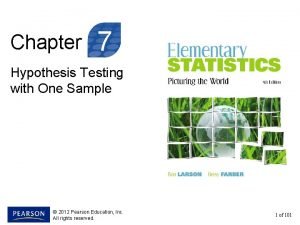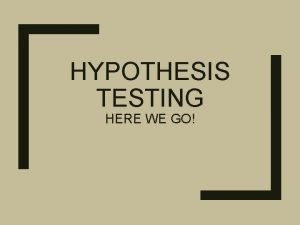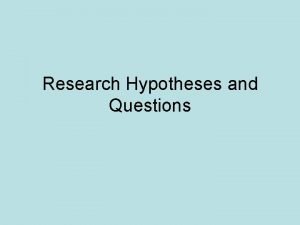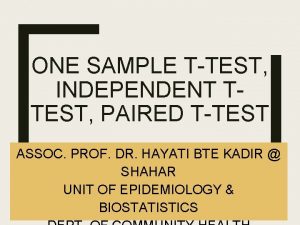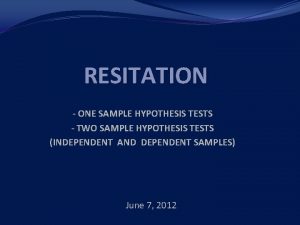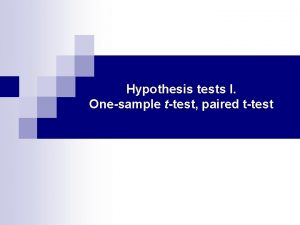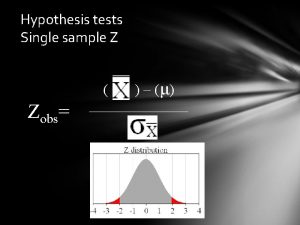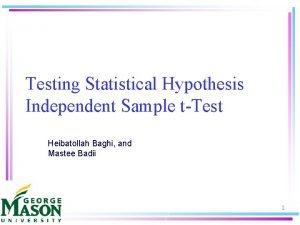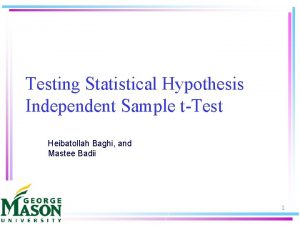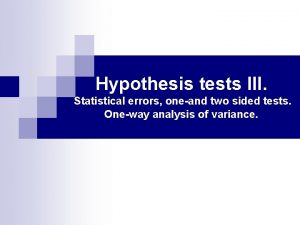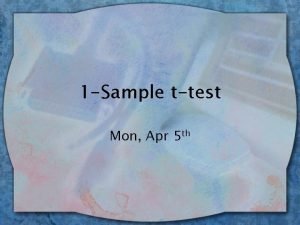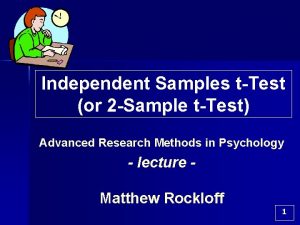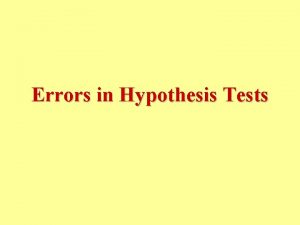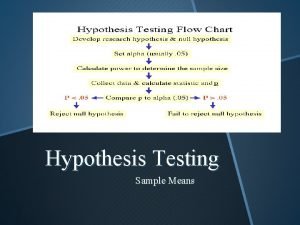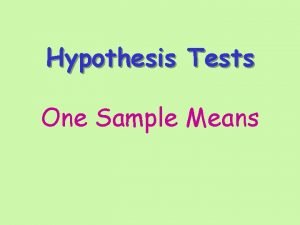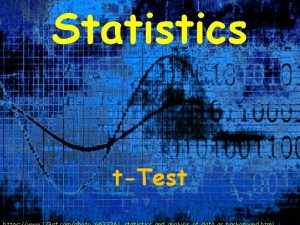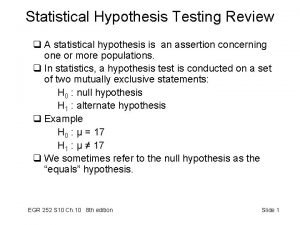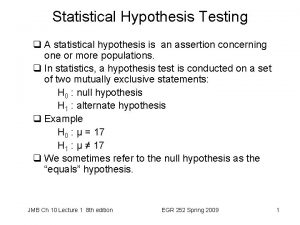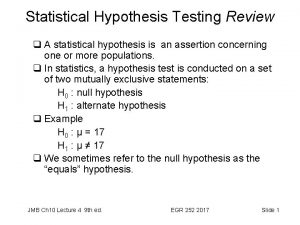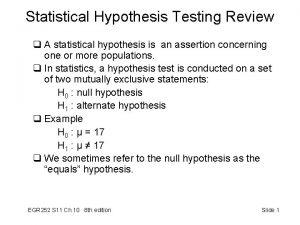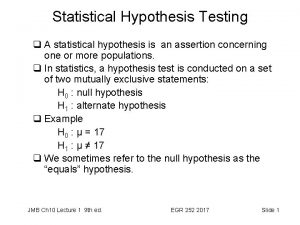Hypothesis tests II Two sample ttest statistical errors

































- Slides: 33

Hypothesis tests II. Two sample t-test, statistical errors.

Motivating example n Two lecturers argue about the mean age of the first year medical students. Is the mean age for boys and girls the same or not? § Lecturer#1 claims that the mean age boys and girls is the same. § Lecturer#2 does not agree. § Who is right? n Statistically speaking: there are two populations: § the set of ALL first year boy medical students (anywhere, any time) § the set of ALL first year girl medical students (anywhere, any time) n n Lecturer#1 claims that the population means are equal: μboys= μgirls. Lecturer#2 claims that the population means are not equal: μboyys ≠ μgirls. 2

Independent samples compare males and females n compare two populations receiving different treatments n compare healthy and ill patients n compare young and old patients n …… n 3

Experimental design of t-tests n n Paired t-test Each subject are measured twice 1 st 2 nd x 1 y 1 x 2 y 2 … … xn yn Two-sample t-test n Each subject is measured once, and belongs to one group. Group Measurement 1 x 1 1 x 2 … … 1 xn 2 y 1 2 y 2 … … 2 ym Sample size is not necessarily equal n 4

Student’s t-tests n n General purpose. Student’s t-tests examine the mean of normal populations. To test hypotheses about the population mean, they use a teststatistic t that follows Student’s t distribution with a given degrees of freedom if the nullhypothesis is true. One-sample t-test. There is one sample supposed to be drawn from a normal distribtuion. We test whether the mean of a normal population is a given constant: § H 0: =c n Paired t-test (=one-sample t-test for paired differences). There is only one sample that has been tested twice (before and after the treatment) or when there are two samples that have been matched or "paired". We test whether the mean difference between paired observations is zero: § H 0: differerence=0 n Two sample t-test (or independent samples t-test). There are two independent samples, coming from two normal populations. We test whether the two population means are equal: § H 0: 1= 2 5

Testing the mean of two independent samples from normal populations: twosample t-test n Independent samples: § § § n Control group, treatment group Male, female Ill, healthy Young, old etc. Assumptions: § Independent samples : x 1, x 2, …, xn and y 1, y 2, …, ym § the xi-s are distributed as N(µ 1, 1) and the yi-s are distributed as N (µ 2, 2 ). n H 0: 1= 2, Ha: 1 2 6

Decision rules Confidence intervals: there are confidence intervals for the difference (we do not study) n Critical points n P-values n If p<0. 05, we say that the result is statistically significant at 5% level: i. e. the effect would occur by chance less than 5% of the time 7

Evaluation of two sample t-test depends on equality of variances 8

n The case when the population standard deviations are equal Assumptions: § 1. Both populations are normal. § 2. The variances of the two populations are equal ( 1= 1 = ). n That is the xi-s are distributed as N(µ 1, ) and the yi-s are distributed as H 0: 1= 2, Ha: 1 2 n If H 0 is true, then n N(µ 2, ) . has Student’s t distribution with n+m-2 degrees of freedom. • Decision: § If |t|>tα, n+m-2, the difference is significant at α level, we reject H 0 § If |t|<tα, n+m-2, the difference is not significant at α level, we do not reject H 0 9

The case when the standard deviations are not equal § Both populations are approximately normal. § 2. The variances of the two populations are not equal ( 1 1 ). § That is the xi-s are distributed as N(µ 1, 1) and the yi-s are distributed as n n H 0: 1= 2, Ha: 1 2 N(µ 2, 2) If H 0 is true, then . has Student t distribution with df degrees of freedom. • Decision: § If |t|>tα, n+m-2, the difference is significant at α level, we reject H 0 § If |t|<tα, n+m-2, the difference is not significant at α level, we do not reject H 0 10

Comparison of the variances of two normal populations: F-test n n H 0: 1= 2 Ha: 1 > 2 (one sided test) F: the higher variance divided by the smaller variance: Degrees of freedom: § 1. Sample size of the nominator-1 § 2. Sample size of the denominator-1 n Decision based on F-table § If F>Fα, table, the two variances are significantly different at α level 11

Table of the F-distribution α=0. 05 Nominator-> Denominator| 12

Example 13

Result of SPSS 14

Two sample t-test, example 2. n n n A study was conducted to determine weight loss, body composition, etc. in obese women before and after 12 weeks in two groups: Group I. treatment with a very-low-calorie diet. Group II. no diet Volunteers were randomly assigned to one of these groups. We wish to know if these data provide sufficient evidence to allow us to conclude that the treatment is effective in causing weight reduction in obese women compared to no treatment. 15

Two sample t-test, cont. Data 16

Two sample t-test, example, cont. n n n HO: diet= control, (the mean change in body weights are the same in populations) Ha: diet control (the mean change in body weights are different in the populations) Assumptions: § normality (now it cannot be checked because of small sample size) § Equality of variances (check: visually compare the two standard deviations) 17

Two sample t-test, example, cont. n Assuming equal variances, compute the t test- statistic: t=2. 477 n Degrees of freedom: 10+11 -2=19 Critical t-value: t 0. 05, 19=2. 093 Comparison and decision: n n § |t|=2. 477>2. 093(=t 0. 05, 19), the difference is significant at 5% level n p=0. 023<0. 05 the difference is significant at 5% level 18

SPSS results Comparison of variances. p=0. 185>0. 05, not significant. We accept the equality of variances Comparison of means (t-test). 1 st row: equal variances assumed. t=2. 477, df=19, p=0. 023 The difference in mean weight loss is significant at 5% level Comparison of means (t-test). 2 nd row: equal variances not assumed. As the equality of variances was accepted, we do not use the results from this row. 19

Example from the medical literature 20

Compare the mean age in the two groups! The sample means are „similar”. Is this small difference really caused by chance? 21

n Step 1. § H 0: the means in the two populations are equal: 1= 2 § HA: the means in the two populations are not equal: 1≠ 2 n Step 2. § Let α=0. 05 n Step 3. § Decision rule: two-sample t-test. n Step 4. Decision. § Decision based on test statistic: n n n Compute the test statistics: t=-1. 059, the degrees of freedom is 14+13 -2=25 ttable=2. 059 |t|=1. 059<2. 059, the difference is not significant at 5% level. § p=0. 28, p>0. 05, the difference is not significant at 5% level. 22

How to get the p-value? n n n If H 0 is true, the computed test statistic has a t-distribution with 25 degrees of freedom. Then with 95% probability, the t-value lies in the „acceptance region” Check it: now t=-1. 059 0. 025 0. 95 0. 025 ttable, critical value 23

How to get the p-value? n n If H 0 is true, the computed test statistic has a t-distribution with 25 degrees of freedom Then with 95% probability, the t-value lies in the „acceptance region” Check it: now t=-1. 059 The p-value is the shaded area, p=0. 28. The probability of the observed test statistic as is or more extreme in either direction when the null hypothesis is true. 0. 025 ttable, critical value 0. 95 0. 025 tcomputed, test statistic 24

How to get the t-value using statistical software – given sample size, sample mean and sample SD? n n Using SPSS, t-test is performed on sample data. Given only sample characteristics, it is difficult to get t. value. Excel: 25

Answer to the motivated example (mean age of boys and girls) n The mean age of boys is a litlle bit higher than the mean age of girls. The standard deviations are similar. n n Comparison of variances (F test for the equality of variances): p=0. 741>0. 05, not significant, we accept the equality of variances. Comparison of means: according to the formula for equal variances, t=1. 505. df=135, p=0. 135. So p>0. 05, the difference is not significant. Althogh the experiencedd difference between the mean age of boys and girls is 0. 816 years, this is statistically not significant at 5% level. We cannot show that the mean age of boay and girls are different. 26

Other aspects of statistical tests 27

One- and two tailed (sided) tests n Two tailed test n H 0: there is no change 1= 2, Ha: There is change (in either direction) 1 2 n n One-tailed test n H 0: the change is negative or zero 1≤ 2 Ha: the change is positive (in one direction) 1> 2 n Critical values are different. p-values: p(one-tailed)=p(two-tailed)/2 28

Significance n n Significant difference – if we claim that there is a difference (effect), the probability of mistake is small (maximum - Type I error ). Not significant difference – we say that there is not enough information to show difference. Perhaps § § n there is no difference There is a difference but the sample size is small The dispersion is big The method was wrong Even is case of a statistically significant difference one has to think about its biological meaning 29

Statistical errors Truth Decision do not reject H 0 (significance) H 0 is true correct Type I. error Ha is true Type II. error its probability: correct its probability: 30

Error probabilities n n n The probability of type I error is known ( ). The probability of type II error is not known ( ) It depends on § § § n The significance level ( ), Sample size, The standard deviation(s) The true difference between populations others (type of the test, assumptions, design, . . ) The power of a test: 1 - It is the ability to detect a real effect 31

The power of a test in case of fixed sample size and , with two alternative hypotheses 32

Review questions and problems n n n The null- and alternative hypothesis of the two-sample t-test The assumption of the two-sample t-test Comparison of variances F-test Testing significance based on t-statistic Testing significance based on p-value Meaning of the p-value One-and two tailed tests Type I error and its probability Type II error and its probability The power of a test In a study, the effect of Calcium was examined to the blood pressure. The decrease of the blood pressure was compared in two groups. Interpret the SPSS results 33
 T test for dependent samples formula
T test for dependent samples formula Paired vs unpaired t test
Paired vs unpaired t test Effect size for t-test
Effect size for t-test Graphpad ttest
Graphpad ttest T-test beispielrechnung
T-test beispielrechnung Proc ttest
Proc ttest Ttest ind
Ttest ind Iq intelligence
Iq intelligence Univariate statistical tests
Univariate statistical tests Statistical tests for ordinal data
Statistical tests for ordinal data Tutor 2 you
Tutor 2 you Statistical tests psychology
Statistical tests psychology Statistical tests psychology
Statistical tests psychology Null hypothesis test formula
Null hypothesis test formula Null hypothesis example
Null hypothesis example Hypothesis test
Hypothesis test Uji z spss
Uji z spss Oregon state assessment portal
Oregon state assessment portal Eqao sample tests grade 3
Eqao sample tests grade 3 Statistical intervals based on a single sample
Statistical intervals based on a single sample Hypothesis in research
Hypothesis in research Null and alternative hypothesis statistics
Null and alternative hypothesis statistics Accept or reject hypothesis
Accept or reject hypothesis Nebular hypothesis and protoplanet hypothesis venn diagram
Nebular hypothesis and protoplanet hypothesis venn diagram There are two equal and opposite errors
There are two equal and opposite errors P(a b) venn diagram
P(a b) venn diagram A chemist performs the same tests on two
A chemist performs the same tests on two Two branch of statistics
Two branch of statistics Sample complexity for finite hypothesis spaces
Sample complexity for finite hypothesis spaces One sample t test formula
One sample t test formula Chapter 7 hypothesis testing with one sample answers
Chapter 7 hypothesis testing with one sample answers Statement of hypothesis example
Statement of hypothesis example Two types of hypothesis
Two types of hypothesis One-way anova hypothesis testing
One-way anova hypothesis testing
